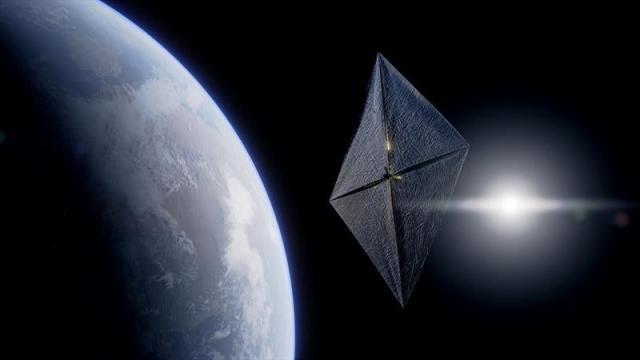A new spacecraft could soon be soaring through Earth’s orbit while gently being pushed by photons emitted from the Sun.
French aerospace company Gama launched its Gama Alpha solar sail mission to test out photonic propulsion technology, which keeps spacecraft in orbit without the need for fuel. The Gama Alpha cubesat was loaded on board a SpaceX Falcon 9 rocket and lifted off on Tuesday morning from Space Launch Complex 40 at Florida’s Cape Canaveral Space Force Station.
As the company’s first solar sail mission, Gama Alpha is an initial test of its technology. The cubesat is roughly the size of a shoebox, while its large solar sail is about the size of a tennis court. The plan is for the sail to unfurl in Earth orbit at an altitude of 550 kilometres, according to a statement by Gama. “The first phase will be commissioning the satellite, establishing communications and checking all the vital signs are good,” Jordan Culeux, Gama lead system engineer, said in the statement. “The second phase will be the sail deployment.”
Solar sails collect photons from the Sun, causing small bursts of momentum that propel the spacecraft. As the photons hit the sails, the spacecraft is pushed farther away from the Sun. If a spacecraft is able to surpass the drag from Earth’s atmosphere, it could potentially reach very high altitudes.
“In space, the Sun’s radiative pressure allows constant acceleration. The result? Missions that are 10 to 20 times less expensive and no longer limited by a fuel budget,” Andrew Nutter, Gama co-founder, said in the statement. “A solar sail is poetic, inherently sustainable, and dramatically lowers the cost of access to deep space or unstable orbits.”
The satellite will enter into a slow rotation once its solar sail is deployed. The main purpose of the Gama Alpha mission is to demonstrate that a large sail can be deployed and controlled by a small cubesat, in addition to collecting flight data to improve simulations of the solar sail technology, according to Gama.
Gama Alpha reached its orbit less than two months after LightSail 2, a pioneering solar sail mission, burnt up in Earth’s atmosphere to end its three-and-a-half year mission. LightSail 2 launched in 2019 to test controlled solar sailing in Earth orbit, inspiring a new generation of soaring spacecraft to follow.
There are several other solar sail missions currently in the works, including NASA’s Advanced Composite Solar Sail System to test out sail boom material in Earth orbit (scheduled for launch sometime this year) and NASA’s Solar Cruiser (scheduled for a 2025 launch). NASA’s NEA Scout solar sail mission launched aboard Artemis 1 in November 2022, but the team behind the mission has been unable to communicate with it ever since.
Gama Alpha will also be followed by a successor mission aptly named Gama Beta. For the follow-up mission, the main objective will be to demonstrate sustained navigation from an altitude twice as high as its predecessor. Should its solar sail missions prove successful, the Gama company is hoping to become a pioneer in the field with this unique, low-cost technology.
“We are building the space transportation infrastructure of tomorrow,” Louis de Goüyon Matignon, Gama co-founder, said in the statement. “While companies today are focused on low Earth orbit, we have decided to look further afield and prepare for the space operations of the future.”
More: LightSail 2, Pushed by Sunlight, Raises Its Orbit by 3,200.40 m in Just Two Weeks
